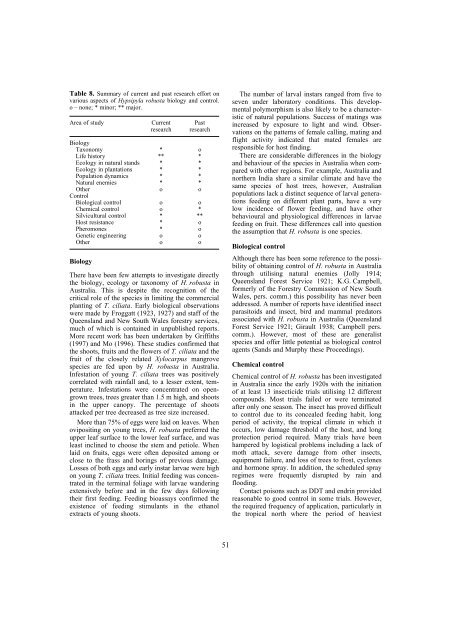Hypsipyla Shoot Borers of Meliaceae in Sri Lanka - Australian ...
Hypsipyla Shoot Borers of Meliaceae in Sri Lanka - Australian ...
Hypsipyla Shoot Borers of Meliaceae in Sri Lanka - Australian ...
You also want an ePaper? Increase the reach of your titles
YUMPU automatically turns print PDFs into web optimized ePapers that Google loves.
Table 8. Summary <strong>of</strong> current and past research effort on<br />
various aspects <strong>of</strong> <strong>Hypsipyla</strong> robusta biology and control.<br />
o – none; * m<strong>in</strong>or; ** major.<br />
Area <strong>of</strong> study Current<br />
research<br />
Biology<br />
Past<br />
research<br />
Biology<br />
Taxonomy * o<br />
Life history ** *<br />
Ecology <strong>in</strong> natural stands * *<br />
Ecology <strong>in</strong> plantations * *<br />
Population dynamics * *<br />
Natural enemies * *<br />
Other o o<br />
Control<br />
Biological control o o<br />
Chemical control o *<br />
Silvicultural control * **<br />
Host resistance * o<br />
Pheromones * o<br />
Genetic eng<strong>in</strong>eer<strong>in</strong>g o o<br />
Other o o<br />
There have been few attempts to <strong>in</strong>vestigate directly<br />
the biology, ecology or taxonomy <strong>of</strong> H. robusta <strong>in</strong><br />
Australia. This is despite the recognition <strong>of</strong> the<br />
critical role <strong>of</strong> the species <strong>in</strong> limit<strong>in</strong>g the commercial<br />
plant<strong>in</strong>g <strong>of</strong> T. ciliata. Early biological observations<br />
were made by Froggatt (1923, 1927) and staff <strong>of</strong> the<br />
Queensland and New South Wales forestry services,<br />
much <strong>of</strong> which is conta<strong>in</strong>ed <strong>in</strong> unpublished reports.<br />
More recent work has been undertaken by Griffiths<br />
(1997) and Mo (1996). These studies confirmed that<br />
the shoots, fruits and the flowers <strong>of</strong> T. ciliata and the<br />
fruit <strong>of</strong> the closely related Xylocarpus mangrove<br />
species are fed upon by H. robusta <strong>in</strong> Australia.<br />
Infestation <strong>of</strong> young T. ciliata trees was positively<br />
correlated with ra<strong>in</strong>fall and, to a lesser extent, temperature.<br />
Infestations were concentrated on opengrown<br />
trees, trees greater than 1.5 m high, and shoots<br />
<strong>in</strong> the upper canopy. The percentage <strong>of</strong> shoots<br />
attacked per tree decreased as tree size <strong>in</strong>creased.<br />
More than 75% <strong>of</strong> eggs were laid on leaves. When<br />
oviposit<strong>in</strong>g on young trees, H. robusta preferred the<br />
upper leaf surface to the lower leaf surface, and was<br />
least <strong>in</strong>cl<strong>in</strong>ed to choose the stem and petiole. When<br />
laid on fruits, eggs were <strong>of</strong>ten deposited among or<br />
close to the frass and bor<strong>in</strong>gs <strong>of</strong> previous damage.<br />
Losses <strong>of</strong> both eggs and early <strong>in</strong>star larvae were high<br />
on young T. ciliata trees. Initial feed<strong>in</strong>g was concentrated<br />
<strong>in</strong> the term<strong>in</strong>al foliage with larvae wander<strong>in</strong>g<br />
extensively before and <strong>in</strong> the few days follow<strong>in</strong>g<br />
their first feed<strong>in</strong>g. Feed<strong>in</strong>g bioassays confirmed the<br />
existence <strong>of</strong> feed<strong>in</strong>g stimulants <strong>in</strong> the ethanol<br />
extracts <strong>of</strong> young shoots.<br />
51<br />
The number <strong>of</strong> larval <strong>in</strong>stars ranged from five to<br />
seven under laboratory conditions. This developmental<br />
polymorphism is also likely to be a characteristic<br />
<strong>of</strong> natural populations. Success <strong>of</strong> mat<strong>in</strong>gs was<br />
<strong>in</strong>creased by exposure to light and w<strong>in</strong>d. Observations<br />
on the patterns <strong>of</strong> female call<strong>in</strong>g, mat<strong>in</strong>g and<br />
flight activity <strong>in</strong>dicated that mated females are<br />
responsible for host f<strong>in</strong>d<strong>in</strong>g.<br />
There are considerable differences <strong>in</strong> the biology<br />
and behaviour <strong>of</strong> the species <strong>in</strong> Australia when compared<br />
with other regions. For example, Australia and<br />
northern India share a similar climate and have the<br />
same species <strong>of</strong> host trees, however, <strong>Australian</strong><br />
populations lack a dist<strong>in</strong>ct sequence <strong>of</strong> larval generations<br />
feed<strong>in</strong>g on different plant parts, have a very<br />
low <strong>in</strong>cidence <strong>of</strong> flower feed<strong>in</strong>g, and have other<br />
behavioural and physiological differences <strong>in</strong> larvae<br />
feed<strong>in</strong>g on fruit. These differences call <strong>in</strong>to question<br />
the assumption that H. robusta is one species.<br />
Biological control<br />
Although there has been some reference to the possibility<br />
<strong>of</strong> obta<strong>in</strong><strong>in</strong>g control <strong>of</strong> H. robusta <strong>in</strong> Australia<br />
through utilis<strong>in</strong>g natural enemies (Jolly 1914;<br />
Queensland Forest Service 1921; K.G. Campbell,<br />
formerly <strong>of</strong> the Forestry Commission <strong>of</strong> New South<br />
Wales, pers. comm.) this possibility has never been<br />
addressed. A number <strong>of</strong> reports have identified <strong>in</strong>sect<br />
parasitoids and <strong>in</strong>sect, bird and mammal predators<br />
associated with H. robusta <strong>in</strong> Australia (Queensland<br />
Forest Service 1921; Girault 1938; Campbell pers.<br />
comm.). However, most <strong>of</strong> these are generalist<br />
species and <strong>of</strong>fer little potential as biological control<br />
agents (Sands and Murphy these Proceed<strong>in</strong>gs).<br />
Chemical control<br />
Chemical control <strong>of</strong> H. robusta has been <strong>in</strong>vestigated<br />
<strong>in</strong> Australia s<strong>in</strong>ce the early 1920s with the <strong>in</strong>itiation<br />
<strong>of</strong> at least 13 <strong>in</strong>secticide trials utilis<strong>in</strong>g 12 different<br />
compounds. Most trials failed or were term<strong>in</strong>ated<br />
after only one season. The <strong>in</strong>sect has proved difficult<br />
to control due to its concealed feed<strong>in</strong>g habit, long<br />
period <strong>of</strong> activity, the tropical climate <strong>in</strong> which it<br />
occurs, low damage threshold <strong>of</strong> the host, and long<br />
protection period required. Many trials have been<br />
hampered by logistical problems <strong>in</strong>clud<strong>in</strong>g a lack <strong>of</strong><br />
moth attack, severe damage from other <strong>in</strong>sects,<br />
equipment failure, and loss <strong>of</strong> trees to frost, cyclones<br />
and hormone spray. In addition, the scheduled spray<br />
regimes were frequently disrupted by ra<strong>in</strong> and<br />
flood<strong>in</strong>g.<br />
Contact poisons such as DDT and endr<strong>in</strong> provided<br />
reasonable to good control <strong>in</strong> some trials. However,<br />
the required frequency <strong>of</strong> application, particularly <strong>in</strong><br />
the tropical north where the period <strong>of</strong> heaviest

















